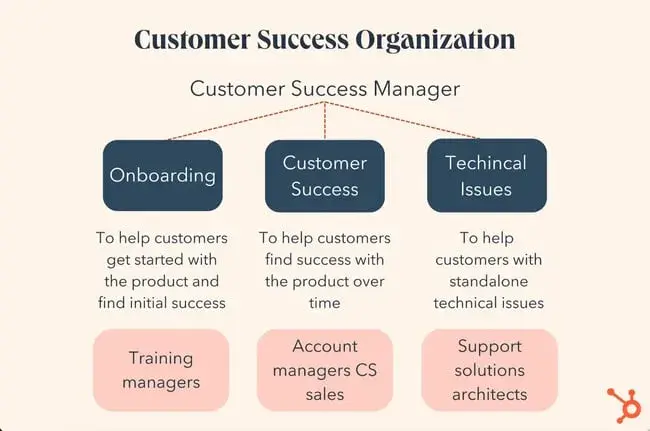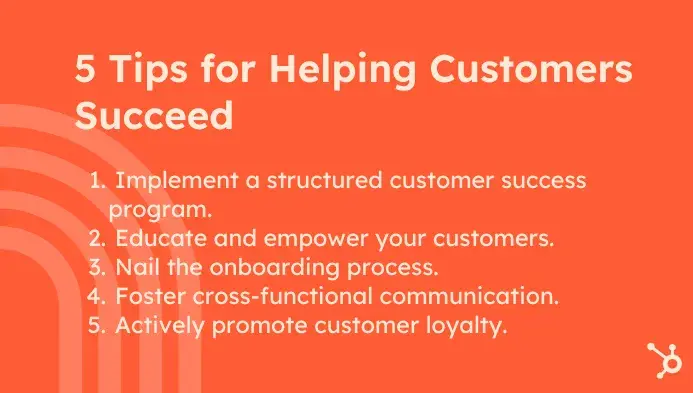This reality underscores the need for a dedicated focus on the customers you already have, ensuring they don’t just stay, but thrive. That’s where customer success comes in.
This post is my deep dive into the field, so grab your free customer success playbook, and let’s get started.
In this article:
- What is customer success?
- What is customer success management?
- Why is customer success so important?
- The Impact of Customer Success
- Customer Success vs. Customer Service
- Customer Success vs. Customer Experience
- How does customer success work?
- Software Tools for Your Customer Success Program
- 5 Tips for Helping Customers Succeed
What is customer success?
Customer success is the proactive approach of anticipating customer needs, challenges, or questions and providing solutions before they become major roadblocks. It’s about guiding customers towards achieving maximum value from your offering.
By handling customer success effectively, you naturally boost customer happiness and retention, which translates directly to increased revenue and stronger customer loyalty. Think of it as partnering with your customers for their long-term win, which ultimately becomes your win too.
Why is customer success so important?
Simply put, customer success fuels business success.
When customers achieve their goals using your product, they stick around. Happy, successful customers are far more likely to renew, expand their usage, and even become your best marketing channel.
Consider this – loyal customers are 5x more likely to purchase again, 4x more likely to refer friends, and 93% of customers are likely to make repeat purchases after receiving excellent service.
Investing in customer success isn’t just about warm feelings — it directly impacts your bottom line by:
- Reducing customer churn.
- Increasing renewal rates and overall customer satisfaction (a metric I’ve always focused heavily on improving).
- Boosting revenue through retention and identifying upsell/cross-sell opportunities. (Selling to existing customers has a 60-70% success rate, far higher than acquiring new ones.)
- Creating a powerful base of brand advocates (77% of customers advocate for a brand that provides a personalized experience).
In my experience building and scaling support operations, a well-executed customer success strategy consistently delivers tangible results, making it an essential function. The success of the support team heavily relies on how successfully new customers get onboarded, and how well those relationships are maintained.
What is customer success management?
Customer success management is overseeing your business's customer success representatives and maintaining a customer success strategy to proactively assist, delight, and retain customers.
A customer success manager leads the team of representatives who work directly with customers. Depending on the size and organization of your company, customer success managers may report to a senior manager or a VP of customer support and success.
Customer success management is critical to the health of an organization as it directly impacts customer retention rates and the rate of cross-sells and upsells.
Key Responsibilities of Customer Success (CS) Managers
- To ensure representatives are helping customers get the most out of the product or service, thus increasing the likelihood of retaining those customers.
- To hire, train, and motivate CS representatives on engagement and retention best practices as well as product or service specificities.
- To develop the organization's customer success strategy to actively engage and retain customers.
- To lead the development of any supporting content and materials needed by CS representatives.
- To segment the customer base by agreed-upon factors, such as subscription type, product adoption, business size, or the like, so that CS representatives can better help them.
- To address any escalated CS issues or questions.
- To encourage customer feedback through direct questioning and/or customer surveys.
- To analyze the feedback, performance, and retention rates of customers based on their interaction with the CS team to better understand the effectiveness of the broader customer success strategy.
The internal organization of your CS team should be based on your team's needs, the size of your employee base, and the complexity of your product.
Here’s a flowchart for how customer success is usually organized.

In this sample organization, the CS manager leads a three-pronged department. One team manages customer onboarding, another heads up long-term customer success, and the third manages one-off technical issues or requests.
In my opinion, this type of team structure allows for more targeted solutions and provides opportunities for your team to build long-term relationships with customers.
The Impact of Customer Success
A strong customer success function is a strong revenue driver and churn mitigator. Let’s dig into the specific, measurable impact.
Boosts Revenue & Retention
Customer success directly impacts metrics like Monthly Recurring Revenue (MRR) and Net Revenue Retention (NRR).
By ensuring customers see value, you secure renewals and create opportunities for expansion. In fact, 94% of companies measuring CS impact use a revenue target like NRR.
Reduces Churn
Proactive engagement, onboarding, and support drastically reduce the likelihood of customers leaving.
Iris Software, for instance, maintained a 98% annual retention rate through proactive CS strategies.
Replacing lost customers is expensive (it takes three new customers to replace one lost existing customer); focusing on success keeps them engaged and loyal.
Increases Customer Lifetime Value (CLTV)
Successful customers stay longer, buy more, and advocate for you. One of your NPS promoters typically has a CLV 600-1400% higher than a detractor.
Drives Advocacy
Happy customers talk. They leave positive reviews and recommend you to others.
While customers tell an average of 9 people about a good experience, they tell 16 about a bad one, highlighting the importance of proactive success management.
Provides Product Feedback
Customer success managers are uniquely positioned to gather insights about how customers use the product and where it falls short, feeding invaluable information back to product development teams, often sourced initially from support interactions.
The message is clear: Investing in customer success is investing in the financial health and long-term growth of your business.
Customer Success vs. Customer Service
While these terms are very related and often work closely together, these two functions have distinct roles. Understanding the difference is key.
- Customer Service: Think of customer service (or support) as primarily reactive. It focuses on solving immediate problems, answering specific questions, and addressing issues as they arise.
Customers typically initiate contact when something is broken, confusing, or not working as expected. The channels often include phone, email, chat, social, and support tickets. Its goal is efficient problem resolution and immediate satisfaction.
- Customer Success (CS): Customer success is fundamentally proactive. It focuses on the long-term relationship and ensuring the customer achieves their desired outcomes and maximum value from the product or service.
It involves strategic guidance, onboarding, regular check-ins, identifying growth opportunities for the customer, and collecting feedback. The goal is long-term value realization, retention, and advocacy.
In my roles leading support teams at companies like Greenhouse Software and SmartRecruiters, I saw how crucial a tight feedback loop with customer success was.
Support tackles the immediate fire, gathering crucial real-time data on pain points (the “what” and “when”).
Success uses that intel, combined with their strategic understanding of the customer’s goals (the “why”), to prevent future fires, guide the customer towards long-term wins, and inform product improvements.
It’s a symbiotic relationship where support provides the immediate pulse check, and success provides the long-term health plan.
Customer Success vs. Customer Experience
Just like I mentioned above, these terms are also closely linked but aren’t interchangeable.
- Customer Experience (CX): CX encompasses the entirety of a customer’s perception of your company, based on all interactions across every touchpoint – from marketing and sales to product usage and interactions with both support and success teams.
It’s the overall feeling and judgment a customer forms about your brand. 90% of businesses now state CX is their top strategic priority, and 86% of customers are willing to pay more for a better experience.
- Customer Success: Success is a specific component and a major driver of the overall customer experience, primarily focused on the post-purchase journey. It’s the function dedicated to ensuring customers achieve value and reach their goals using your product/service.
A great CS program, often informed by insights gathered during support interactions, significantly contributes to a positive overall CX.
Think of CX as the big picture. Customer success is a critical piece, ensuring the customer’s investment pays off long after the sale. After all, 73% of consumers say a good experience is key to their brand loyalty, making both proactive success and efficient support vital.
How does customer success work?
There are three elements needed for customer success to be effective:
- A customer success solution (e.g., a tool or software).
- A manager and team of customer success employees.
- A customer success strategy.
1. Choose and use a customer success solution.
To manage relationships proactively, you need the right tools. These range from dedicated customer success platforms (used by 82% of companies with over 500 employees) to integrated CRM and service suites.
Support tools like Zendesk, which I’ve used extensively throughout my career, often need to integrate tightly with CS platforms to share data seamlessly. The goal is tracking health, managing interactions, and automating where possible — and 88% of CS platform users say it helps them spend more time on meaningful customer engagement.
2. Hire and train a dedicated team.
You'll need a person (or preferably a team) to work on customer success. I like to think of customer success representatives as your company’s “product teachers.” The number of representatives, or product teachers, and managers on your customer success team will depend on the size of your business and available resources.
Note: It’s important to remember to expand your customer success team as your company grows so you can proactively assist your customer base. Not having enough customer success representatives can lead to problems and unhappy clients.
3. Create a clear customer success strategy.
Depending on the product you sell and what your customers need from you, your customer success strategy may vary a bit.
However, here are some universal steps to creating a customer success strategy for your team:
- Establish a customer success team.
- Implement the appropriate customer success tools and software.
- Identify your customers' end goals (and why they need customer success).
- Create a roadmap for success to explain your business's expectations and goals for customer success in both the short and long term.
- Share and implement the strategy on your team, and ensure everyone knows what's expected of them individually and as a team.
- Analyze your results. Do your customers have the tools and support they need to succeed?
- Modify your customer success strategy and the team as your business and customer base grow.
Pro tip: For more guidance and best practices, grab our free customer success playbook.
Now that you have a better understanding of customer success and why it's so important, I’ll share some ways to help your customers succeed.
Software Tools for Your Customer Success Program
While strategy and people are paramount, the right software is crucial. Customer success platform users are 41% more likely to report headcount growth, suggesting these tools enable scaling for their orgs.
Here are a few tools I’ve looked into that teams often use to support their customer success efforts. The key is choosing a solution (or combination of tools) that fits your team’s specific processes, the scale of your customer base, integration needs, and overall budget.
1. HubSpot Service Hub
What I immediately noticed about HubSpot is that it’s part of a much larger ecosystem. The Service Hub specifically offers ticketing, help desk automation, knowledge base creation, customer feedback surveys (like NPS, CSAT), live chat, and reporting dashboards.
Since it integrates tightly with HubSpot’s Sales and Marketing Hubs, I could see a unified view of customer interactions across different departments, which seemed incredibly powerful for a holistic customer view.
It also supports automation for ticket routing, escalations, and triggering tasks based on customer feedback.
Price: The Starter plan starts at $20/month per seat (billed monthly), and important to note, a free plan is available that doesn’t expire! You also have the option to upgrade to Professional for $1,450/month for 5 seats (billed monthly), or Enterprise for $4,700/month for 7 seats.
What I like: The biggest draw for me was the potentially all-in-one integration. Having customer service data seamlessly connected with sales and marketing activities within the same platform is a huge advantage. It avoids data silos and provides a single source of truth.
The free plan is also a major plus, allowing teams to start small and scale up without an immediate financial commitment. The user interface felt intuitive, especially if you’re already familiar with other CRM platforms.
I personally use HubSpot for my side business because I can easily manage contacts and create lists, which is very helpful when automating email marketing initiatives.
2. Zendesk Suite
Having managed support teams that relied heavily on Zendesk in the past, I know how focused and robust it is for customer service operations. Its ticketing system is highly configurable with powerful triggers and automations for workflows – something I utilized extensively.
It also offers multi-channel support (email, chat, voice, social), a customizable help center/knowledge base, community forums, and advanced reporting. It’s truly designed to handle high volumes of support interactions efficiently, which has always been a top priority in my roles.
Price: Pricing starts around $19/month per agent which is great for small teams, but they also offer various plan tiers ranging from $55/month per agent to $115/month per agent. They don’t offer a free plan, but a 14-day trial is typically available upon request.
What I like: Zendesk’s ticketing system is powerful and mature. What I particularly appreciated was the flexibility of its triggers and automations. We could build complex workflows to automatically route tickets based on type or urgency, escalate issues that passed certain time thresholds, or notify specific teams when keywords were mentioned. This significantly improved our team’s efficiency and response times.
Managing conversations across multiple channels within that single agent workspace was also essential for providing seamless support. While Zendesk does require more initial setup than some simpler tools, that investment pays off with the deep customization options for workflows and the help center, allowing you to tailor it precisely to complex support needs – something I found very valuable.
3. Front
I’ve always heard good things about Front, so it was interesting to finally try it out. It presented a unique angle centered around the shared team inbox, managing channels like email, SMS, chat, and social collaboratively.
Some of the key features I noted were conversation assignment, internal commenting (invisible to the customer), collision detection, rule-based automation, and integrations.
Price: Pricing ranges from $19 - $99/month per user, with a free trial (billed annually).
What I like: Now that I’ve tried Front, the emphasis on team collaboration around communication really stood out. Instead of emails getting lost or multiple people accidentally replying, Front provides a clear structure.
The feature I found particularly efficient was the ability to have internal discussions right next to the customer conversation without switching tools or forwarding emails internally. It felt incredibly well-suited for teams managing high volumes of shared inbox communication transparently and collaboratively.
4. Intercom
Intercom struck me as being heavily focused on conversational relationships and proactive engagement. Having used its live chat functionality in previous roles, I’ve always admired its modern approach and intuitive design.
Its core strength is the messenger embedded in websites/apps. It includes features for targeted outbound messages based on user behavior, customizable chatbots, product tours, and integrated help articles. It really aims to blend support, sales, and marketing conversations.
Price: Pricing starts at $29/month per seat to $132/month per seat, with a free 14-day trial (billed annually).
What I like: I really admire the modern, integrated messenger experience. It feels less like a traditional ticket system and more like an ongoing conversation. What stands out is the ability to proactively message users based on their specific actions within an app or website – for instance, offering help if someone seems stuck on a certain feature.
This targeted engagement felt very powerful for both support and driving feature adoption. The combination of live chat, these proactive messages, and bots, make it effective for a highly conversational customer approach.
5. Survicate
Trying Survicate for the first time, it clearly stands out as a dedicated customer feedback tool. I noticed its focus on creating and distributing surveys – NPS, CSAT, CES, or custom ones – via multiple channels like email, website widgets/pop-ups, links, or in-app messages.
I also saw targeting capabilities and integrations to push feedback into other systems like CRMs. Naturally, it includes reporting to analyze the responses, too.
Price: Survicate has two pricing plans with different tiers. There’s the Essential plans – offering the Free, Starter ($79/month), and Growth ($49/month) tiers. There’s also the Advanced plans – offering the Volume ($299/month), Pro ($299/month), and Enterprise ($499/month) tiers. You can start any of the Essential plans for free.
What I like: I appreciated its keen focus specifically on feedback collection. It seems very capable at doing one thing well – understanding customer sentiment. The flexibility in survey types and distribution methods adds some versatility.
What seemed particularly useful was the website intercept option (widgets/pop-ups), allowing you to capture feedback in context right as a user interacts with your site. The low price and free plan make it easy to start gathering voice-of-customer data, and integrating that feedback is key for actionability. I think I’ll try this one again in the future.
5 Tips for Helping Customers Succeed
Feel free to modify the following list of customer success tips to better suit your customers and their needs. Every business and base of customers is different, so you might find that some of these tips work better than others for your specific situation.

1. Implement a structured customer success program.
Create a customer success program to guide your team to effectively and proactively assist your customers. Every business will have a version of a customer success strategy, so ensure your customer success strategy meets the needs and expectations of your customers.
If you haven’t already, I suggest you take a minute to really dig into your customer's mind. Figure out what they like, what they need, their expectations, and their core characteristics. Sending a survey to your client base can help you design your customer success program.
If you need extra help to create your customer success program, I encourage you to check out our customer success playbook. This playbook will give you step-by-step guidance, proven strategies, and industry best practices to help you craft your own customer success strategy.
Pro tip: As a small business owner myself, I understand how some strategies get pushed to the side as your business grows. But, as I’ve learned, don't forget to modify your strategy as your business grows — the needs of your customers are bound to change over time, especially as your products and features evolve.
2. Educate and empower your customers.
To best support your customers, you need to anticipate the questions that are bound to arise as they work with your products. Remember when I called customer success representatives “product teachers”? This is where the teaching part comes into play.
To ensure your customers are not sitting on the phone on hold or waiting on your response, empower them through education about your product. Research has shown that 68% of customers use a product more after proper training, and 87% report being more self-sufficient.
This is especially important if you sell a complex product or service like software. For example, you can create a knowledge base where you list product and feature descriptions or include live chat on your site so success reps can better support your customers in real-time. Hosting weekly webinars to showcase your product’s core features and functionality is a great lead generation strategy to draw in new customers while also providing real onboarding and training to new ones.
3. Nail the onboarding process.
Onboard your customers to support them throughout the initial parts of their journey with your brand and product. Provide them with the tools, training, resources, and knowledge they need to get the ball rolling. I think onboarding customers is a great way to delight them and get them acquainted with your product — all while answering any questions proactively.
By onboarding your customers, you set the tone for what to expect from your business throughout the rest of the time they're customers. As a customer support manager myself, this can really make the difference between a customer who has a lot of issues using the product/service, or someone who is well-trained and ready to execute their strategy.
Examples of onboarding materials include step-by-step tutorials, unlimited one-on-one guidance from reps, demo videos, and milestone celebrations when a customer achieves success using your product.
Pro tip: I’ve written plenty of FAQs and step-by-step guides for customers. When you create these kinds of materials, it’s helpful to get into the mindset of your customer. Although your product might be intuitive, it’s helpful to write down each and every step for how to use it.
4. Foster cross-functional communication.
Customer success doesn’t operate in a vacuum. Ensure you have tight collaboration with:
- Sales. It’s important to have a smooth handoff and to understand customer goals from the start.
- Marketing. Try to align messaging and leverage content for customer education.
- Product. Aim to relay customer feedback and advocate for necessary improvements.
- Support: Aim to coordinate reactive and proactive efforts seamlessly.
For example, at Skybound, I collaborate with our game dev team to work on player-reported game issues. We also proactively address newly discovered issues that haven’t yet been reported.
5. Actively promote customer loyalty.
Loyalty stems from consistently delivering positive experiences and perceived value.
There are many ways to promote customer loyalty to establish brand advocates and promoters who increase your customer retention rates.
You can:
- Explore customer loyalty programs.
- Build customer communities.
- Offer exclusive perks.
Remember, selling to existing customers has been shown to be 60-70% more likely than selling to new ones, and 93% of customers are likely to make repeat purchases after excellent service.
You Succeed When Your Customers Do
My journey through various customer-facing roles has cemented one core belief: Your growth is intrinsically linked to your customers’ achievements.
Just like a student thrives with dedicated support and resources, a customer flourishes when a business invests proactively in their success. By building a customer success function, you’re not just managing accounts – you’re building partnerships, fostering loyalty, and creating advocates.
This proactive, deeply customer-centric approach isn’t optional – it’s the bedrock of sustainable growth and long-term business health in today’s demanding market. Invest in their success, and they’ll power yours.
Net Promoter, Net Promoter System, Net Promoter Score, NPS and the NPS-related emoticons are registered trademarks of Bain & Company, Inc., Fred Reichheld and Satmetrix Systems, Inc.
Editor's note: This article was originally published in July 2017 and has since been updated for comprehensiveness.
Customer Success




![How To Write a CSM Resume [+ Free Templates]](https://53.fs1.hubspotusercontent-na1.net/hubfs/53/customer-success-manager-resume-1-20241031-2293336.webp)







